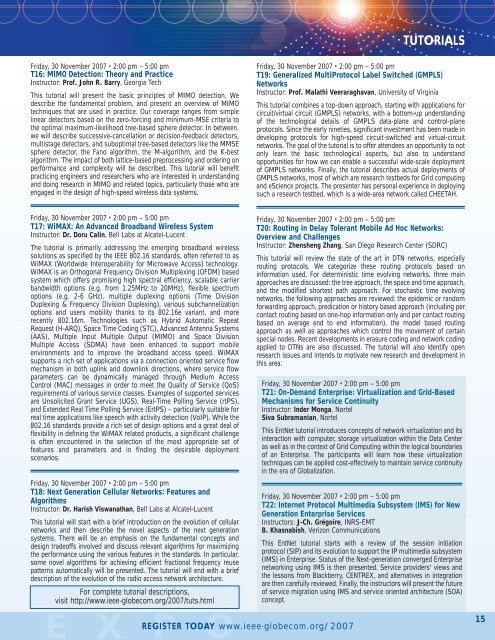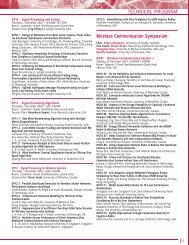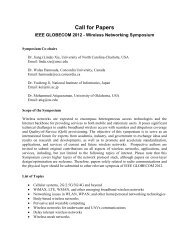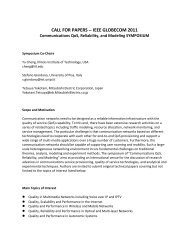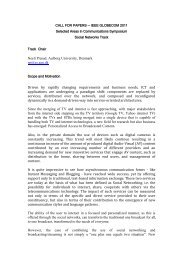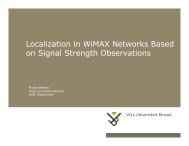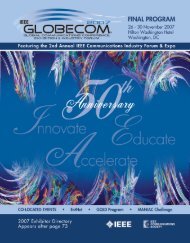information - IEEE GLOBECOM 2013
information - IEEE GLOBECOM 2013
information - IEEE GLOBECOM 2013
You also want an ePaper? Increase the reach of your titles
YUMPU automatically turns print PDFs into web optimized ePapers that Google loves.
TUTORIALS<br />
Friday, 30 November 2007 • 2:00 pm – 5:00 pm<br />
T16: MIMO Detection: Theory and Practice<br />
Instructor: Prof. John R. Barry, Georgia Tech<br />
This tutorial will present the basic principles of MIMO detection. We<br />
describe the fundamental problem, and present an overview of MIMO<br />
techniques that are used in practice. Our coverage ranges from simple<br />
linear detectors based on the zero-forcing and minimum-MSE criteria to<br />
the optimal maximum-likelihood tree-based sphere detector. In between,<br />
we will describe successive-cancellation or decision-feedback detectors,<br />
multistage detectors, and suboptimal tree-based detectors like the MMSE<br />
sphere detector, the Fano algorithm, the M-algorithm, and the K-best<br />
algorithm. The impact of both lattice-based preprocessing and ordering on<br />
performance and complexity will be described. This tutorial will benefit<br />
practicing engineers and researchers who are interested in understanding<br />
and doing research in MIMO and related topics, particularly those who are<br />
engaged in the design of high-speed wireless data systems.<br />
Friday, 30 November 2007 • 2:00 pm – 5:00 pm<br />
T19: Generalized MultiProtocol Label Switched (GMPLS)<br />
Networks<br />
Instructor: Prof. Malathi Veeraraghavan, University of Virginia<br />
This tutorial combines a top-down approach, starting with applications for<br />
circuit/virtual circuit (GMPLS) networks, with a bottom-up understanding<br />
of the technological details of GMPLS data-plane and control-plane<br />
protocols. Since the early nineties, significant investment has been made in<br />
developing protocols for high-speed circuit-switched and virtual-circuit<br />
networks. The goal of the tutorial is to offer attendees an opportunity to not<br />
only learn the basic technological aspects, but also to understand<br />
opportunities for how we can enable a successful wide-scale deployment<br />
of GMPLS networks. Finally, the tutorial describes actual deployments of<br />
GMPLS networks, most of which are research testbeds for Grid computing<br />
and eScience projects. The presenter has personal experience in deploying<br />
such a research testbed, which is a wide-area network called CHEETAH.<br />
Friday, 30 November 2007 • 2:00 pm – 5:00 pm<br />
T17: WiMAX: An Advanced Broadband Wireless System<br />
Instructor: Dr. Doru Calin, Bell Labs at Alcatel-Lucent<br />
The tutorial is primarily addressing the emerging broadband wireless<br />
solutions as specified by the <strong>IEEE</strong> 802.16 standards, often referred to as<br />
WiMAX (Worldwide Interoperability for Microwave Access) technology.<br />
WiMAX is an Orthogonal Frequency Division Multiplexing (OFDM) based<br />
system which offers promising high spectral efficiency, scalable carrier<br />
bandwidth options (e.g. from 1.25MHz to 20MHz), flexible spectrum<br />
options (e.g. 2-6 GHz), multiple duplexing options (Time Division<br />
Duplexing & Frequency Division Duplexing), various subchannelization<br />
options and users mobility thanks to its 802.16e variant, and more<br />
recently 802.16m. Technologies such as Hybrid Automatic Repeat<br />
Request (H-ARQ), Space Time Coding (STC), Advanced Antenna Systems<br />
(AAS), Multiple Input Multiple Output (MIMO) and Space Division<br />
Multiple Access (SDMA) have been enhanced to support mobile<br />
environments and to improve the broadband access speed. WiMAX<br />
supports a rich set of applications via a connection oriented service flow<br />
mechanism in both uplink and downlink directions, where service flow<br />
parameters can be dynamically managed through Medium Access<br />
Control (MAC) messages in order to meet the Quality of Service (QoS)<br />
requirements of various service classes. Examples of supported services<br />
are Unsolicited Grant Service (UGS), Real-Time Polling Service (rtPS),<br />
and Extended Real Time Polling Service (ErtPS) – particularly suitable for<br />
real time applications like speech with activity detection (VoIP). While the<br />
802.16 standards provide a rich set of design options and a great deal of<br />
flexibility in defining the WiMAX related products, a significant challenge<br />
is often encountered in the selection of the most appropriate set of<br />
features and parameters and in finding the desirable deployment<br />
scenarios.<br />
Friday, 30 November 2007 • 2:00 pm – 5:00 pm<br />
T18: Next Generation Cellular Networks: Features and<br />
Algorithms<br />
Instructor: Dr. Harish Viswanathan, Bell Labs at Alcatel-Lucent<br />
This tutorial will start with a brief introduction on the evolution of cellular<br />
networks and then describe the novel aspects of the next generation<br />
systems. There will be an emphasis on the fundamental concepts and<br />
design tradeoffs involved and discuss relevant algorithms for maximizing<br />
the performance using the various features in the standards. In particular,<br />
some novel algorithms for achieving efficient fractional frequency reuse<br />
patterns automatically will be presented. The tutorial will end with a brief<br />
description of the evolution of the radio access network architecture.<br />
For complete tutorial descriptions,<br />
visit http://www.ieee-globecom.org/2007/tuts.html<br />
Friday, 30 November 2007 • 2:00 pm – 5:00 pm<br />
T20: Routing in Delay Tolerant Mobile Ad Hoc Networks:<br />
Overview and Challenges<br />
Instructor: Zhensheng Zhang, San Diego Research Center (SDRC)<br />
This tutorial will review the state of the art in DTN networks, especially<br />
routing protocols. We categorize these routing protocols based on<br />
<strong>information</strong> used. For deterministic time evolving networks, three main<br />
approaches are discussed: the tree approach, the space and time approach,<br />
and the modified shortest path approach. For stochastic time evolving<br />
networks, the following approaches are reviewed: the epidemic or random<br />
forwarding approach, predication or history based approach (including per<br />
contact routing based on one-hop <strong>information</strong> only and per contact routing<br />
based on average end to end <strong>information</strong>), the model based routing<br />
approach as well as approaches which control the movement of certain<br />
special nodes. Recent developments in erasure coding and network coding<br />
applied to DTNs are also discussed. The tutorial will also identify open<br />
research issues and intends to motivate new research and development in<br />
this area.<br />
Friday, 30 November 2007 • 2:00 pm – 5:00 pm<br />
T21: On-Demand Enterprise: Virtualization and Grid-Based<br />
Mechanisms for Service Continuity<br />
Instructor: Inder Monga, Nortel<br />
Siva Subramanian, Nortel<br />
This EntNet tutorial introduces concepts of network virtualization and its<br />
interaction with computer, storage virtualization within the Data Center<br />
as well as in the context of Grid Computing within the logical boundaries<br />
of an Enterprise. The participants will learn how these virtualization<br />
techniques can be applied cost-effectively to maintain service continuity<br />
in the era of Globalization.<br />
Friday, 30 November 2007 • 2:00 pm – 5:00 pm<br />
T22: Internet Protocol Multimedia Subsystem (IMS) for New<br />
Generation Enterprise Services<br />
Instructors: J-Ch. Grégoire, INRS-EMT<br />
B. Khasnabish, Verizon Communications<br />
This EntNet tutorial starts with a review of the session initiation<br />
protocol (SIP) and its evolution to support the IP multimedia subsystem<br />
(IMS) in Enterprise. Status of the Next-generation converged Enterprise<br />
networking using IMS is then presented. Service providers' views and<br />
the lessons from Blackberry, CENTREX, and alternatives in integration<br />
are then carefully reviewed. Finally, the instructors will present the future<br />
of service migration using IMS and service oriented architecture (SOA)<br />
concept.<br />
E X P O<br />
REGISTER TODAY www.ieee-globecom.org/2007<br />
15


